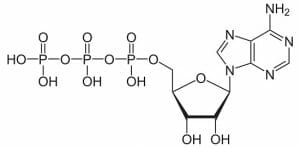Adenosine Triphosphate Definition
Adenosine triphosphate, also known as ATP, is a molecule that carries energy within cells. It is the main energy currency of the cell, and it is an end product of the processes of photophosphorylation (adding a phosphate group to a molecule using energy from light), cellular respiration, and fermentation. All living things use ATP. In addition to being used as an energy source, it is also used in signal transduction pathways for cell communication and is incorporated into deoxyribonucleic acid (DNA) during DNA synthesis.
Structure of ATP

This is a structural diagram of ATP. It is made up of the molecule adenosine (which itself is made up of adenine and a ribose sugar) and three phosphate groups. It is soluble in water and has a high energy content due to having two phosphoanhydride bonds connecting the three phosphate groups.
Functions of ATP
Energy Source
ATP is the main carrier of energy that is used for all cellular activities. When ATP is hydrolyzed and converted to adenosine diphosphate (ADP), energy is released. The removal of one phosphate group releases 7.3 kilocalories per mole, or 30.6 kilojoules per mole, under standard conditions. This energy powers all reactions that take place inside the cell. ADP can also be converted back into ATP so that the energy is available for other cellular reactions.
ATP is produced through several different methods. Photophosphorylation is a method specific to plants and cyanobacteria. It is the creation of ATP from ADP using energy from sunlight, and occurs during photosynthesis. ATP is also formed from the process of cellular respiration in the mitochondria of a cell. This can be through aerobic respiration, which requires oxygen, or anaerobic respiration, which does not. Aerobic respiration produces ATP (along with carbon dioxide and water) from glucose and oxygen. Anaerobic respiration uses chemicals other than oxygen, and this process is primarily used by archaea and bacteria that live in anaerobic environments. Fermentation is another way of producing ATP that does not require oxygen; it is different from anaerobic respiration because it does not use an electron transport chain. Yeast and bacteria are examples of organisms that use fermentation to generate ATP.
Signal Transduction
ATP is a signaling molecule used for cell communication. Kinases, which are enzymes that phosphorylate molecules, use ATP as a source of phosphate groups. Kinases are important for signal transduction, which is how a physical or chemical signal is transmitted from receptors on the outside of the cell to the inside of the cell. Once the signal is inside the cell, the cell can respond appropriately. Cells may be given signals to grow, metabolize, differentiate into specific types, or even die.
DNA Synthesis
The nucleobase adenine is part of adenosine, a molecule that is formed from ATP and put directly into RNA. The other nucleobases in RNA, cytosine, guanine, and uracil, are similarly formed from CTP, GTP, and UTP. Adenine is also found in DNA, and its incorporation is very similar, except ATP is converted into the form deoxyadenosine triphosphate (dATP) before becoming part of a DNA strand.
ATP, ADP, AMP, cAMP
Other molecules are related to ATP and have similar names, such as adenosine diphosphate (ADP), adenosine monophosphate (AMP), and cyclic AMP (cAMP). In order to avoid confusion, it is important to know some differences between these molecules.
ADP
Adenosine diphosphate (ADP), which is sometimes also known as adenosine pyrophosphate (APP), especially in chemistry, has already been mentioned in this article. It differs from ATP because it has two phosphate groups. ATP becomes ADP with the loss of a phosphate group, and this reaction releases energy. ADP itself is formed from AMP. Cycling between ADP and ATP during cellular respiration gives cells the energy needed to carry out cellular activities.
AMP
Adenosine monophosphate (AMP), also called 5’-adenylic acid, has only one phosphate group. This molecule is found in RNA and contains adenine, which is part of the genetic code. It can be produced along with ATP from two ADP molecules, or by hydrolysis of ATP. It is also formed when RNA is broken down. It can be converted into uric acid, which is a component of urine, and excreted via the bladder.
cAMP
Cyclic adenosine monophosphate (cAMP) is derived from ATP and is another messenger used for signal transduction and activating certain protein kinases. It can be broken down into AMP. cAMP pathways may play a role in certain cancers such as carcinoma. In bacteria, it has a role in metabolism. When a bacterial cell is not producing enough energy (from insufficient glucose, for example), high cAMP levels occur, and this turns on genes that use energy sources other than glucose.
Related Biology Terms
- Cellular respiration – Energy from nutrients is converted into ATP.
- Signal transduction – The transmission of signals from a cell’s outside to its inside.
- Hydrolysis – Breaking a bond in a molecule and splitting it into smaller molecules through a reaction with water.
- Kinase – An enzyme that transfers a phosphate group from ATP to another molecule.
Quiz
1. How can ATP be produced?
A. Fermentation
B. Cellular respiration
C. Photophosphorylation
D. All of the above
2. Where is ATP made in the cell?
A. Mitochondria
B. Nucleus
C. Ribosomes
D. Endoplasmic reticulum
3. Adenine is found in what type of genetic material?
A. DNA
B. RNA
C. Both DNA and RNA
D. Neither DNA nor RNA
